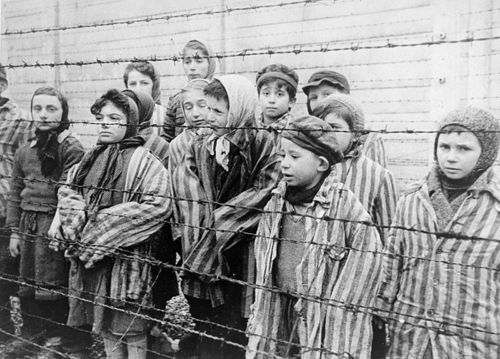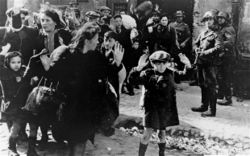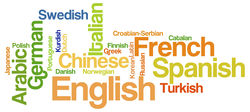Difference between revisions of "Category:Holocaust Children Studies--1940s"
| Line 62: | Line 62: | ||
|} | |} | ||
|} | |} | ||
[[File:1947 OSE.jpg|150px]] | |||
==== 1947 ==== | ==== 1947 ==== | ||
Revision as of 12:56, 21 February 2022
|
|
Holocaust Children Studies : 2020s -- 2010s -- 2000s -- 1990s -- 1980s -- 1970s -- 1960s -- 1950s -- 1940s -- 1930s -- Home General : 2020s -- 2010s -- 2000s -- 1990s -- 1980s -- 1970s -- 1960s -- 1950s -- 1940s -- 1930s -- 1920s -- 1910s -- 1900s -- 1850s -- 1800s -- 1700s -- 1600s -- 1500s -- 1450s -- Medieval -- Home
|
1947
- Benjamin Tennebaum, ed., Ehad me-ir u shenayim mi-mishpahah: Mivhar m’elef autobigrafiot shel yaldei Yisrael b’Polin [One of a City and Two of a Family: A Selection from a Thousand Autobiographies of Jewish Children in Poland] (Merhavyah, Israel: Sifriat Poalim, 1947) <Hebrew>.
- Maria Hochberg-Marianskwa and Noe Grüss, eds. Dzieci Oskarzaja (Cracow-Łódź-Warsaw: Central Jewish Historical Commission in Poland, 1947) <Polish>. English tr. The Children Accuse (London: Vallentine-Mitchell, 1996)
This most unusual book contains evidence collected by the author in 1945 in Poland from children and teenagers who surfaced from hiding in forests and bunkers and told the story of their survival as it happened. The interviews, expertly translated from the original Polish, document life in the ghettos, the camps, in hiding, in the resistance and in prison. There is also a series of interviews with adults who lived and worked alongside children in wartime Poland.--Publisher description.
- Noe Grüss (Noah Gris), ed. Kinder-martirologye: zamlung fun dokumentn [Children’s Martyrdom: A Document Collection] (Buenos Aires [Argentina]: Tsentral-farband fun Poylishe Yidn in Argentine, 1947) <Yiddish>
"The future of surviving children was a major issue in post-Holocaust Jewish society ... Less known is the fact that correspondingly, much effort was put into listening to the child survivors, recording their stories, and publishing them. By 1947 three anthologies of children’s testimonies were published [in Israel, Poland, and Argentina] bringing to the public the stories of child survivors as they told them." Some children's testimonies were also collected and published in the Yiddish journal Fun Lezten Hurban, the first-ever Holocaust research journal, published in Munich during 1946– 48. The journal was published by the Central Historical Commission in Munich, which was established in December 1945 by the Central Committee for the Liberated Jews in Germany. The commission collected thousands of testimonies from Holocaust survivors in the DP camps, among them hundreds from child survivors of the Holocaust. The drive to collect testimonies from children was initiated by Israel Kaplan (1902–2003), a teacher from Kovno who together with Moshe Feigenboim led the commission. The child survivors and their stories held a strong fascination with Kaplan, whose own child survived the Holocaust in hiding and on the run. Out of hundreds of testimonies collected from child survivors by the staff of the Central Historical Commission during its more than three years of existence, eight were selected for publication in the journal issues."--See Boaz Cohen, Representing Children's Holocaust
1948
Lena Küchler-Silberman. Mayne Kinder (Paris: Aroysgegebn durkhn Yidishn folksfarband in Frankraykh, 1948) <Yiddish>.
My Hundred Children (London : Souvenir Press; and Garden City, NY: Doubleday, 1961).
Also translated into Hebrew (1959).
"The author recounts how she led a hundred Jewish orphans out of postwar Poland to safety in Israel"--Publisher description.
Lena Küchler-Silberman (1910-1987) was a Jewish teacher, educator and psychologist. She was born and grew up in Wieliczka, Poland. After completing her studies in the Hebrew gymnasium in Kraków she went on to study philosophy, psychology and pedagogy. During the Holocaust, she lived as a alias outside the Warsaw ghetto, being able to smuggle several children out of the ghetto. After the war, she travelled to the Jewish council in Krakow where she met young children who had lost their families. She took them in, giving them a home in a house she found in Zakopane. From there they made their way to Czechoslovakia, France, and finally, in 1949, Israel.
Media in category "Holocaust Children Studies--1940s"
The following 18 files are in this category, out of 18 total.
- 1942 Pichel (film).jpg 235 × 355; 50 KB
- 1943 Krása opera.jpg 440 × 627; 164 KB
- 1944 Gerron (doc).jpg 190 × 281; 8 KB
- 1945 Berg.jpg 334 × 499; 41 KB
- 1945 Borwicz - Rost - Wulf.jpg 187 × 270; 10 KB
- 1946 Asscher.jpg 181 × 279; 9 KB
- 1946 Berg it.jpg 260 × 346; 17 KB
- 1946 Kaplan.jpg 187 × 269; 7 KB
- 1947 Frank.jpg 250 × 383; 49 KB
- 1947 Grüss.jpg 188 × 268; 13 KB
- 1947 Hochberg - Grüss.jpg 128 × 184; 3 KB
- 1947 OSE.jpg 1,200 × 1,635; 355 KB
- 1947 Tenenbaum.jpg 650 × 907; 119 KB
- 1948 Ford (film).jpg 440 × 617; 67 KB
- 1948 Gross film.jpg 209 × 288; 23 KB
- 1948 Heyman.jpg 318 × 462; 50 KB
- 1948 Küchler-Silberman.jpg 503 × 678; 209 KB
- 1948 Zinnemann film.jpg 245 × 445; 28 KB





















